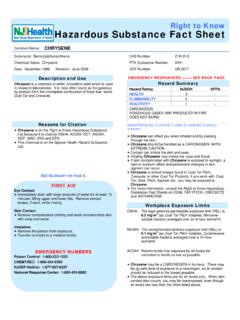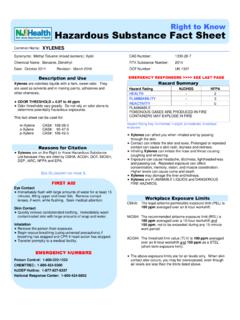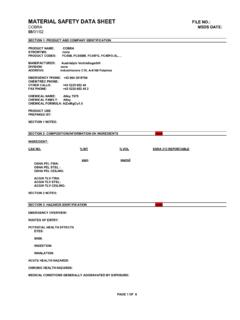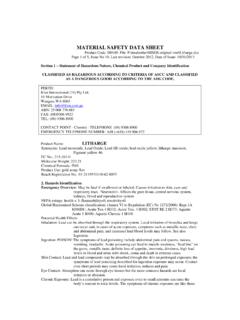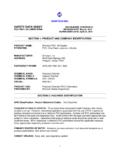Transcription of MATERIAL SAFETY DATA SHEET - whchem.com
1 MATERIAL SAFETY data SHEET DATE 2012-1-1 SDS NO. NAME HDI EDITION WANHUA CHEMICAL GROUP CO., LTD Section 1-CHEMICAL PRODUCT AND COMPANY IDENTIFICATION Chemical Product : Hexamethylene diisocyanate 1,6-diisocyantohexane Product Name: Wannate HDI Company Identification Wanhua Chemical Group Co., Ltd. South Xingfu Road, Yantai ,Shandong China Zip code 264002 Fax 0535-6875138 For emergencies Tel +86 535 3388958 +86 532 83889090 Manufacturer: Wanhua Chemical (Ningbo) Co., Ltd Huandao North Road, Daxie Development Zone, Ningbo, Zhejiang, PRC Section 2 HAZARDS IDENTIFICATION Important hazards: Toxic by inhalation. Irritating to eyes, respiratory system and skin. May cause sensitisation by inhalation and skin contact. Toxic to aquatic organisms, may cause long-term adverse effects in the aquatic environment.
2 GHS Classification: Acute Tox: - Category 3 H331, Eye Irrit. - Category 2 H319, STOT SE - Category 3 H335, Skin Irrit. - Category 2 H315, Resp. Sens. - Category 1 H334, Skin Sens. - Category 1 H317 Symbols: Signal Words: Danger Hazard Statements: The product is toxic by inhalation. It severely irritates the skin and may cause reddening, swelling, inflammation and rashes. The vapors irritate the mucous membranes of the eyes and the respiratory tract, causing watering of the eyes and coughing. Lasting damage to the eyes is possible. Skin contact and possibly also inhalation may cause sensitization. Precautionary Statements: Prevention: Avoid breathing dust/gas/fumes/vapor/spray. Only operate in outdoors or well ventilated place after given specific guidance. Don t use before reading and understanding all SAFETY precautions.
3 Use individual protective equipments as required. Avoid contacting with eyes, skin. Clean thoroughly after operation. NAME HDI SDS NO. WANHUA CHEMICAL GROUP CO., LTD 2/8 Response: If inhaled, transfer the patients to fresh air place and keep the body position good for breathing and call poison control center or doctor immediately. If contact or anxious, go to hospital. Skin contact: wash with plenty of soap and water. If skin irritation or rash appear: go to a doctor. Remove contaminated clothing and can be used again after washing. If contact with eyes: carefully rinse with water for a few minutes. Take out contact lenses and continuous wash. If eyes irritation last: go to a doctor.
4 Storage: Store in a cool, dry and well ventilated warehouse. Keep away from fire and heat source. Keep container sealed. Store separately from oxidant, acid, alkali, alcohol and food chemicals. Equipped with corresponding varieties and number of fire equipment. Storage area should be equipped with emergency treatment equipment and appropriate containers for absorbing leakage. Disposal: The storage of barrels with residual MATERIAL should be avoided from water for preventing burst. Without free-pollution disposal, barrels shall not be stored food and other materials, so as not to cause harmful to human body and environment. Recycling, utilization and disposal of packaging should be complying with national and local relevant laws and regulations. Harm and loss caused by improper disposal of packaging MATERIAL , the disposal party should take responsibility.
5 Important symptoms: NFPA rating: Flammable=1 Health=4 Reactivity=1 HAZARD TO HUMANS AND THE ENVIRONMENT Hazard by inhalation, eye contact and ingestion. Irritating to eyes, respiratory system and skin. May cause sensitization by inhalation and skin contact. Section 3-COMPOSITION / INFORMATION ON INGREDIENTS Substance/mixture : Substance NAME CAS RN % Hexamethylene diisocyanate 822-06-0 Section 4-FIRST AID MEASURES INHALATION: If inhaled, remove to fresh air. If not breathing give artificial respiration. If breathing is difficult, give oxygen. SKIN CONTACT: In case of skin contact, flush with copious amounts of water for at least 15 minutes. Remove contaminated clothing and shoes. Call a physician.
6 EYE CONTACT: In case of contact with eyes, flush with copious amounts of water for at least 15minutes. Assure adequate flushing by separating the eyelids with fingers. Call a physician. 1 41 11 NAME HDI SDS NO. WANHUA CHEMICAL GROUP CO., LTD 3/8 INGESTION: If swallowed, wash out mouth with water provided person is conscious. Call a physician immediately. Section 5 -FIRE FIGHTING MEASURES EXTINGUISHING MEDIA Suitable: Water spray. Carbon dioxide, dry chemical powder, or appropriate foam. SPECIAL RISKS Specific Hazard(s): Emits toxic fumes under fire conditions. SPECIAL PROTECTIVE EQUIPMENT FOR FIREFIGHTERS Wear self-contained breathing apparatus and protective clothing to prevent contact with skin and eyes.
7 Section6-ACCIDENTAL RELEASE MEASURES PERSONAL PRECAUTION PROCEDURES TO BE FOLLOWED IN CASE OF LEAK OR SPILL Evacuate area. PROCEDURE(S) OF PERSONAL PRECAUTION(S) Wear self-contained breathing apparatus, rubber boots, and heavy rubber gloves. METHODS FOR CLEANING UP Cover with dry-lime, sand, or soda ash. Place in covered containers using non-sparking tools and transport outdoors. Ventilate area and wash spill site after MATERIAL pickup is complete. Section 7 - HANDLING AND STORAGE HANDLING Directions for Safe Handling: Do not breathe vapor. Do not get in eyes, on skin, on clothing. Avoid prolonged or repeated exposure. STORAGE Conditions of Storage: Keep tightly closed containers. Precautions must be taken to avoid contamination by moisture and air. Processability of this MATERIAL can be adversely affected by contamination.
8 Water or moisture in the air reacts with the product to generate pressure. SPECIAL REQUIREMENTS Moisture sensitive. Section 8-EXPOSURE CONTROLS / PERSONAL PROTECTION Hexamethylene-1,6-Diisocyanate (822-06-0) US. ACGIH Threshold Limit Values Time Weighted Average (TWA): ppm Germany Exposure Limit Ceiling Limit Value: ppm Industrial Hygiene/Ventilation Measures Local exhaust should be used to maintain levels below the exposure limits or guidelines whenever diisocyanate is handled, processed, or spray-applied. At normal room temperature (70 F) HDI levels quickly exceed the exposure limits or guidelines NAME HDI SDS NO. WANHUA CHEMICAL GROUP CO., LTD 4/8 unless properly ventilated.
9 Standard reference sources regarding industrial ventilation should be consulted for guidance about adequate ventilation. To ensure that exposure limits or guidelines have not been exceeded, monitoring for airborne diisocyanates should become part of the overall employee exposure characterization program. NIOSH, OSHA and others have developed sampling and analytical methods. Respiratory Protection At normal room temperatures, airborne HDI can exceed the appropriate standard/guideline; therefore, in inadequately ventilated environments respiratory protection must be worn. The type of respiratory protection selected must comply with the requirements set forth in OSHA's Respiratory Protection Standard (29 CFR ). The type of respiratory protection available includes (1) an atmosphere-supplying respirator such as a self-contained breathing apparatus (SCBA) or a supplied air respirator (SAR) in the positive pressure or continuous flow mode, or (2) an air-purifying respirator (APR).
10 If an APR is selected, the following conditions must be met: (1) (a) the cartridge must be equipped with an end-of-service life indicator (ESLI) certified by NIOSH, or (1) (b) a change out schedule, based on objective information or data that will ensure that the cartridges are changed out before the end of their service life, must be developed and implemented. The basis for the change out schedule must be described in the written respirator program.(2) the airborne HDI concentration must be no greater than 10 times the appropriate standard/guideline. Hand Protection Gloves should be worn. Nitrile rubber showed excellent resistance. Butyl rubber, neoprene, and PVC are also effective. Eye Protection When directly handling liquid product, eye protection is required. Examples of eye protection include a chemical SAFETY goggle, or chemical SAFETY goggle in combination with a full face shield when there is a greater risk of splash.


